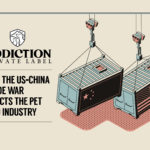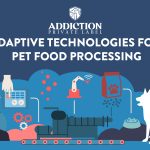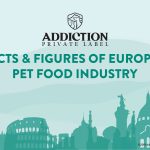This two-part series looks at the challenges of entering the China pet food market
and how Addiction Foods Private Label can help you get your brand there.
China’s economy has grown rapidly over the past decades, and the rise in disposable household income opened a sizeable opportunity for businesses to thrive, including the country’s pet nutrition segment.
Its pet food industry grew at a rate of 6.3% in 2010 and jumped to 21% over 2017 (GfK & NBS Asia).
In the early 2000s, global pet food brands found their way into China, introducing commercial pet food at a time when almost 75 percent of Chinese pet owners provided their pets with homemade meals.
Their timely market entry and the convenient feeding methods that came with them, contributed to China’s fast-growing pet food industry, which has become appealing to foreign pet food companies seeking opportunities to expand their business internationally.
Amidst growing safety concerns on pet food production, more Chinese pet owners are now choosing to buy reliable, foreign-branded premium pet food over domestic ones.
China’s pet food categories and regulations
In 2018, manufacturers faced a fresh set of challenges when China’s Ministry of Agriculture (MOA) issued new and stricter regulations for pet food products both made in China and in foreign countries.
These policies intended to regulate the pet food market environment and guarantee the safety and quality of pet food products available in the Chinese market.
The new regulations were made applicable to pet food under the following categories:
- Pet compound feed, a compound of multiple feed materials and additives at fixed proportions. This category includes complete pet food (dry, wet and canned food).
- Pet feed additive premix, a compound of nutritional additives and carriers/diluents at fixed proportions. This category includes pet food supplements or complementary foods like nutritional pastes.
- Other pet feed, a compound of multiple feed materials and additives at fixed proportions which are used to reward pets. This category includes dog chews, meat bars, biscuits, drinks, and canned treats.
China’s new labeling requirements
The MOA also updated its pet food labeling requirements, which manufacturers and retailers need to meet by 1 September 2019.
All pet food labels should be written in Mandarin, and must clearly indicate the following:
- Product name
- Ingredients composition
- Guaranteed analysis value
- Net content
- Storage condition
- Instructions for use
- Matters needing attention
- Production date
- Shelf-life
- Name and address of the manufacturer
- Approval number and product standards
- Products with animal-derived ingredients except milk and dairy must include this statement: “This product shall not be fed to ruminant”
- Prescription-based pet compound feed must include this statement:
“Please use under the guidance of the veterinarian”
Pet food labels must also specify that the product complies with China’s Pet Feed Hygiene Regulation and must be free from the following:
- Inorganic pollutants and nitrogen-containing compounds like Fluorine, Cadmium, Chromium, Mercury, Lead, Arsenic, Melamine, and Nitrite
- Fungal toxins like Aflatoxin B1, Fumonisins (B1 and B2), Vomitoxin/DON, Zearalenone, Ochratoxin A, and T-2 HT-2 toxin (for cats)
- Natural plant toxins like Cyanide
- Organic chloride pollutants like DDT, PCB, HCH, and HCB
- Microbial contaminants like Salmonella and other microorganisms
Discover how Addiction Foods can help get your brand into the Chinese market.









